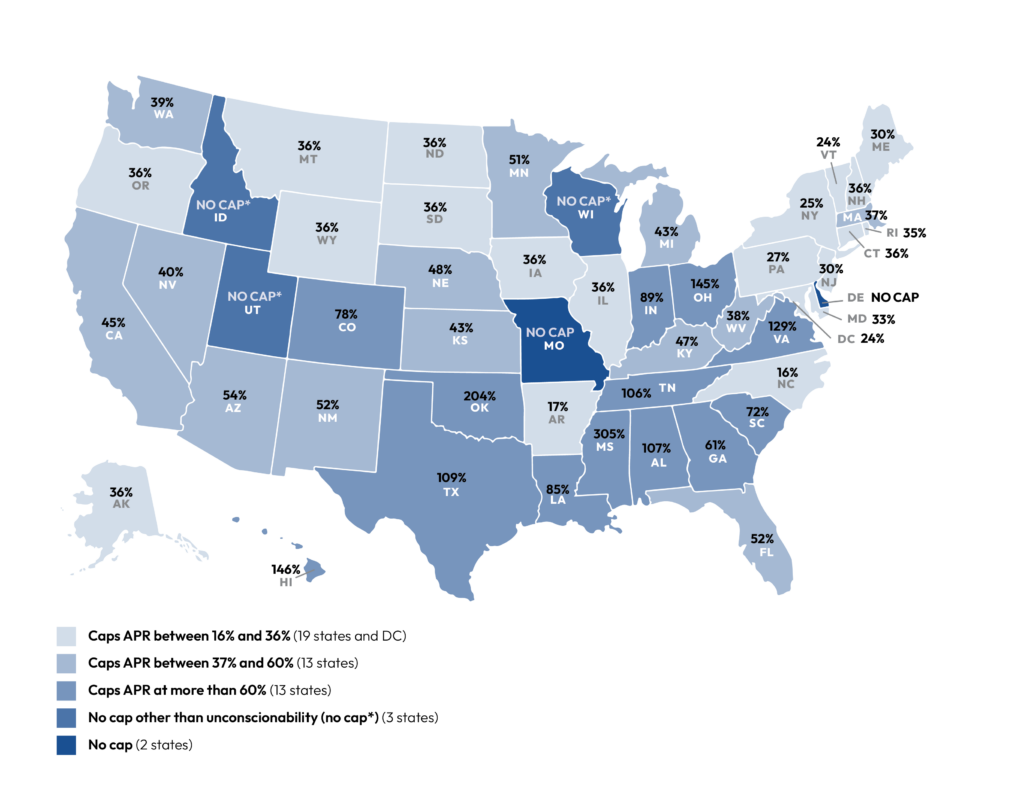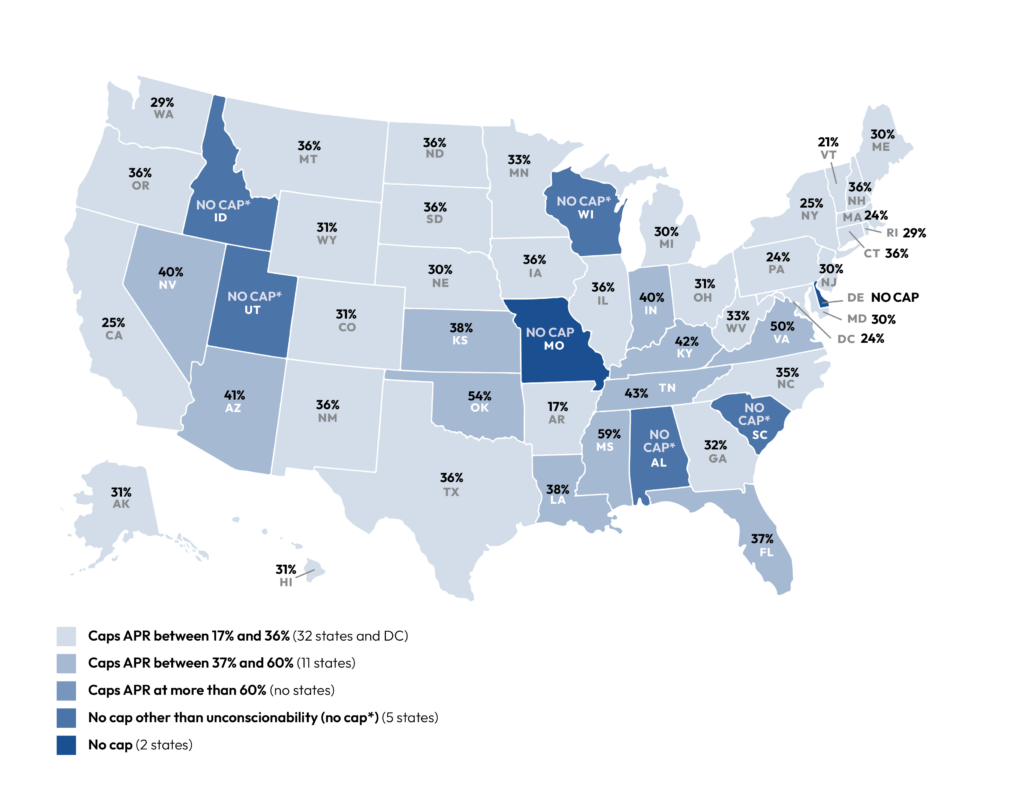© Copyright 2024, National Consumer Law Center, Inc. All rights reserved.
Caps on interest rates and junk fees are the primary vehicle by which states protect consumers from predatory lending. Forty-five states and the District of Columbia currently cap interest rates and loan fees for at least some consumer installment loans, depending on the size of the loan. However, interest rate caps vary greatly from state to state, some states allow lenders to pile on junk fees, and a few states do not cap interest rates at all. We recommend an airtight annual percentage rate (APR) cap of no more than 36% for loans of up to $1,000, and significantly lower limits for larger loans.
Map 1: APRs Allowed for a Six-Month $500 Installment Loan
This map shows the maximum APRs allowed by the states for closed-end installment loans (loans in which the amount borrowed and the repayment period are set at the outset) by licensed non-bank lenders.

For a $500, six-month installment loan, 45 states and DC cap rates, at a median of 39.5% APR.
- 19 states and the District of Columbia cap the annual percentage rate (APR) between 16% and 36%.
- 13 states cap the APR between 37% and 60%.
- 13 states cap the APR at more than 60%.
- Three states—Idaho, Utah, and Wisconsin—require only that the loan not be “unconscionable” (a legal principle that bans terms that shock the conscience).
- Two states—Delaware and Missouri—impose no cap at all.
Map 2: APRs Allowed for a Two-Year $2,000 Installment Loan
This map shows the maximum APRs allowed by the states for closed-end installment loans by licensed non-bank lenders.

For a $2,000, two-year installment loan, 43 states and DC cap rates, at a median of 34% APR.
- 32 states and the District of Columbia cap the APR between 17% and 36%.
- 11 states cap it between 37% and 60% APR.
- Five states—Alabama, Idaho, South Carolina, Utah, and Wisconsin—require only that the loan not be “unconscionable.”
- Two states—Delaware and Missouri—impose no cap at all.
Details about our methodology can be found in Appendix A, and citations to the state laws in Appendix C.
Why States Should Cap Interest Rates and Fees
Caps on interest rates and loan fees are the primary vehicle by which states protect consumers from predatory lending. In the absence of caps, exploitative lenders move into a state, overwhelming responsible lenders and pushing abusive loan products that trap low-income consumers in never-ending debt.
“It was like I asked for help to dig out of this hole and just created a deeper hole for me to inhabit.”
NPR interview of Sarah Ahmed who borrowed $2,300 at 98% to rent an apartment and get her young son set up in an after-school program.
Interest rate caps are more than numbers: they are reflections of society’s collective judgment about moral and ethical behavior. Interest rate caps embody fundamental values. Interest rate caps also reflect an assessment about the upper limits of sustainable lending that does not undermine individual or societal economic stability. When states eliminate high-cost loans by imposing rate caps, consumers generally agree that they are better off and express relief that the loans are no longer available. Elimination of high-cost loans spurs an increase in affordable loans, benefiting all borrowers.
Rate caps also encourage lenders to ensure that the borrower has the ability to repay the loan. Excessive interest rates enable lenders to profit from loans even if many borrowers eventually default. The lender has little incentive to ensure that each borrower can actually afford to repay the loan in full on its terms if the lender can be made whole even if the borrower defaults, or can recoup defaults from exorbitant rates on others.
High-cost loans, including high-cost installment loans, have a disproportionate impact on communities of color. Use of high-cost non-bank installment loans increased between 2021 and 2022 only for Black and Latino/Hispanic households, almost tripling for Black households. High-cost lenders have long targeted these communities. High-cost loans do not promote financial inclusion. Instead, they add to debt, increase struggles, drive borrowers out of the banking system, and exacerbate existing disparities.
The APR is an Essential Standard for Measuring and Comparing the Cost of a Loan
The rates listed above are the annual percentage rates (APRs) as calculated under the Truth in Lending Act (TILA) for installment loans. The APR is a critical way to measure and compare the cost of a loan, because it takes into account both interest and fees, and the length of the repayment period. Otherwise, lenders could pile junk fees on top of interest without reflecting the full cost of the loan in the APR.
For example, a $500 line of credit offered by a predatory lender in Pennsylvania in 2006 charged just 5.98% interest, but required a $149 junk fee every month, producing an actual APR of 431% if repaid over six months.
The APR provides a common, apples-to-apples comparison of the cost of two different loans, even if they have different rate and fee structures or are used to borrow different amounts for different periods of time. Some lenders have diverted attention from the APR to focus instead on the dollar cost. But $15 for a $100 loan is a lot more expensive if you have the loan for only two weeks and not a full year – just like a $100 car rental would be far more costly if one company gave it to you for one day and the other for two weeks.
The Military Lending Act (MLA) places a 36% military APR (MAPR) cap on loans to members of the military and their families. The MAPR takes into account not just interest and fees but also credit insurance charges and other add-on charges. The MAPR is also far more accurate than the TILA APR for measuring the cost of open-end credit such as lines of credit because it includes fees. Because of this, the MAPR is the gold standard for measuring the cost of a loan. However, because of the difficulty of identifying the cost of credit insurance and other add-ons allowed, in the abstract, by the various state laws (as opposed to calculating the MAPR for a given loan), we have used the TILA APR rather than the MAPR in the rates displayed above.
Why 36% or Less for Small Loans, Lower for Larger Loans?
The 36% rate cap is a widely accepted measure of the top acceptable rate for a small dollar loan, and the rate has been broadly supported by both lenders and the general public as the maximum cost for small loans. But 36% is still a high rate, and states that have lower rates should not raise their rates to that level.
For loans in the thousands of dollars, 36% is far too high. Interest increases dramatically with larger, longer loans, even if the rates are not in the triple digits. Many states recognize the need for lower rates on larger loans by adopting tiered interest rate caps. For a five-year $10,000 loan, the borrower will pay $6,972 in interest, and the borrower’s monthly payment will be $282.86. If the state allowed 36% on the whole amount, the same loan would cost the borrower $11,680 in interest—$4,708 more.
Accordingly, a tiered structure that lowers rates as loans get bigger is appropriate.
Significant Changes in the States Since Mid-2022: Crackdowns on Evasions and Auto Title Loans, But Increasing APRs
Since mid-2023, Washington significantly strengthened its protection against evasions of its consumer lending laws, and Kentucky abolished high-cost auto title lending.
On the other hand, Florida increased its top interest rate from 30% to 36% and allowed it to be charged for larger loans for which it is entirely inappropriate. Kansas also extended its top interest rate—36%—to larger loans, and Mississippi extended a 59% APR, previously limited to loans of $4,000 or less, to loans of up to $5,100. Oklahoma’s and Texas’s APR caps keep creeping upward due to annual adjustments of these states’ already high fees and the loan sizes for which higher interest is allowed. In addition, Texas made a one-time increase to one of its loan fees.
Details about the new laws:

Florida weakened its protections against high-cost lending by increasing its top rate to 36% and allowing that rate to be charged on the first $10,000 of a loan. (2024 Fla. Sess. Law Serv. Ch.l 2024-276 (H.B. 1347)). As a result, with allowable fees included, the maximum APR for a $500 6 month loan increased from 48% to 52%, and the maximum APR for a $2,000 2-year loan increased from 31% to 37%. Formerly, the top rate was 30%, and it could be charged only on the first $3,000 of the loan.

Kansas weakened its protections against high-cost lending by increasing the interest rates it allows from 36% on the first $860 of a loan and 21% on the remainder to 36% on the entire loan, effective January 1, 2025. (2024 Kan. Laws Ch. 6 (H.B. 2247)). As a result, the maximum APR for a $2,000 2-year loan increased from 32% to 38%.

Kentucky abolished high-cost auto title loans by repealing the statute that allowed them. (2024 Ky. Laws Ch. 152 (HB 726)). While this report addresses only unsecured loans, not loans secured by a car, the title to a car, or other property, the Kentucky bill nonetheless represents a significant step forward for consumers in the state.

Under a Mississippi amendment (2024 Miss. Laws S.B. 2543), the abusive 59% APR allowed by the Consumer Alternative Installment Loan Act is no longer limited to loans of $4,000 or less, but can be charged on loans up to $5,100 (to be increased annually for inflation). This change affects only loans larger than those analyzed in this report, however.

Oklahoma announced inflation adjustments for a “closing fee,” increasing it from $178.87 to $184.64, and for monthly fees allowed under one of its calculation methods.

The Texas Finance Commission increased a junk fee from $100 to $125, and adopted a policy of increasing the fee every year to account for inflation.

Washington substantially strengthened its protections against evasions of its consumer loan laws, making it even clearer that the state’s 36% APR cap encompasses all amounts a consumer pays in connection with the loan, and tightening restrictions on rent-a-bank lending. (2024 Wash. Legis. Serv. Ch. 249 (S.S.B. 6025)).
Appendix B summarizes earlier changes in state lending laws, going back to 2017.
Recommendations: A 36% APR Cap for Small Loans, Lower for Larger Loans
To protect consumers from high-cost lending, states should:
- Cap APRs at no more than 36% for smaller loans, such as those of $1,000 or less, with significantly lower rates for larger loans.
- Prohibit loan fees or strictly limit them to prevent fees from being used to undermine the interest rate cap and acting as an incentive for loan flipping.
- Include all payments in the APR calculation, whether or not they are deemed “voluntary.” Some lenders have tried to disguise fees as purportedly voluntary “tips,” expedite fees, or donations.
- Prevent loopholes for open-end credit. Rate caps on installment loans will be ineffective if lenders can evade them through open-end lines of credit with low interest rates but high fees.
- Ban the sale of credit insurance and other add-on products, which primarily benefit the lender and increase the cost of credit.
- Examine consumer lending bills carefully. Predatory lenders often propose bills that obscure the true interest rate, for example, by presenting it as 24% per year plus 7/10ths of a percent per day instead of 279%. Or the bill may list the per-month rate rather than the annual rate. Get a calculation of the full APR, including all interest, all fees, and all other charges, and reject the bill if it is over 36% (or if it applies a 36% APR to more than the very smallest loans).
- Include anti-evasion provisions to prevent lenders from laundering their loans through out-of-state banks to evade state rate caps or disguising their loans as sales, “earned wage” payments, or other devices.
In addition, states should make sure that their loan laws address other potential abuses. States should:
- Require lenders to evaluate the borrower’s ability to repay any credit that is extended.
- Prohibit mechanisms, such as security interests in household goods and post-dated checks, which coerce repayment of unaffordable loans.
- Require proportionate rebates of all up-front loan charges when loans are refinanced or paid off early.
- Limit balloon payments, interest-only payments, and excessively long loan terms. An outer limit of 24 months for a loan of $1,000 or less and 12 months for a loan of $500 or less might be appropriate, with shorter terms for higher-rate loans.
- Employ robust licensing and reporting requirements, including default and late payment rates, for lenders.
- Include strong enforcement mechanisms, including making unlicensed or unlawful loans void and uncollectible, and providing a private right of action with attorneys’ fees.
- Tighten up other lending laws, including credit services organization laws, to prevent evasions.
See NCLC’s 2015 report on high-cost small loans for more details on these issues and on issues that arise for open-end credit. In addition, see our Rent-a-Bank Lending and Fintech Credit pages for more information about the latest issues.
In the absence of rate limits at the federal level, state interest and fee caps are the primary bulwark against predatory lending. By following these guidelines, states can ensure that their laws are effective at protecting consumers.
Authors and Acknowledgments
Co-authors: Carolyn Carter, deputy director, National Consumer Law Center; Andrew Pizor, senior attorney, National Consumer Law Center, Lauren Saunders, associate director, National Consumer Law Center.
This research was funded by the Annie E. Casey Foundation, and we thank it for its support; however, the findings and conclusions presented in this report are those of the authors alone, and do not necessarily reflect the opinions of the Foundation. The authors thank NCLC colleagues Michael Best, Emily Green Caplan, Michelle Deakin, Ella Halpine, Anna Kowanko, Stephen Rouzer, and Margot Saunders for assistance.
Related Resources
- NCLC’s High-Cost Loans online content
- Issue Brief: National Consumer Law Center, After Payday Loans: Consumers Find Better Ways to Cope with Financial Challenges (March 2022)
- Issue Brief: Why Cap Interest Rates at 36%? (August 2021)
- Report: Predatory Installment Lending in the States: How Well Do the States Protect Consumers Against High-Cost Installment Loans? (November 2023)
- Report: Larger Loans Need Lower Rates: A 50-State Survey of the APRs Allowed for a $10,000 Loan (March 2024)
- Report: Misaligned Incentives: Why High-Rate Installment Lenders Want Borrowers Who Will Default (July 2016)
- Report: Installment Loans: Will States Protect Borrowers from a New Wave of Predatory Lending? (July 2015)
See all resources related to: High-Cost Credit

